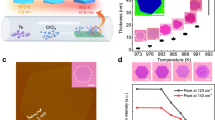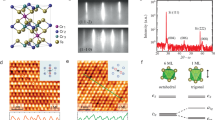Abstract
Two-dimensional materials that are intrinsically ferromagnetic are crucial for the development of compact spintronic devices. However, most non-layered 2D magnets with a strong ferromagnetic order are difficult to synthesize. Here we show that the flakes of trigonal and monoclinic Cr5Te8 can be grown via a chemical vapour deposition method. Using magneto-optical and magnetotransport measurements, we show that both phases exhibit robust ferromagnetism with strong perpendicular anisotropy at thicknesses of a few nanometres. A high Curie temperature of up to 200 K can be obtained by manipulating the phase structure and thickness. We also observe a colossal anomalous Hall effect in the more structurally distorted monoclinic Cr5Te8, with an anomalous Hall conductivity of 650 Ω−1 cm−1 and anomalous Hall angle of 5%.
This is a preview of subscription content, access via your institution
Access options
Access Nature and 54 other Nature Portfolio journals
Get Nature+, our best-value online-access subscription
$29.99 / 30 days
cancel any time
Subscribe to this journal
Receive 12 digital issues and online access to articles
$119.00 per year
only $9.92 per issue
Buy this article
- Purchase on Springer Link
- Instant access to full article PDF
Prices may be subject to local taxes which are calculated during checkout





Similar content being viewed by others
Data availability
The data that support the findings of this study are available from the corresponding authors upon reasonable request.
Code availability
The code for calculating the Stoner parameter and spin ordering is available from the corresponding authors upon reasonable request.
References
Gong, C. et al. Discovery of intrinsic ferromagnetism in two-dimensional van der Waals crystals. Nature 546, 265–269 (2017).
Huang, B. et al. Layer-dependent ferromagnetism in a van der Waals crystal down to the monolayer limit. Nature 546, 270–273 (2017).
Li, T. et al. Pressure-controlled interlayer magnetism in atomically thin CrI3. Nat. Mater. 18, 1303–1308 (2019).
Fei, Z. et al. Two-dimensional itinerant ferromagnetism in atomically thin Fe3GeTe2. Nat. Mater. 17, 778–782 (2018).
Deng, Y. et al. Gate-tunable room-temperature ferromagnetism in two-dimensional Fe3GeTe2. Nature 563, 94–99 (2018).
Gibertini, M., Koperski, M., Morpurgo, A. & Novoselov, K. Magnetic 2D materials and heterostructures. Nat. Nanotechnol. 14, 408–419 (2019).
Zhang, Y. et al. Ultrathin magnetic 2D single‐crystal CrSe. Adv. Mater. 31, 1900056 (2019).
Zhou, S. et al. Ultrathin non‐van der Waals magnetic rhombohedral Cr2S3: space‐confined chemical vapor deposition synthesis and Raman scattering investigation. Adv. Funct. Mater. 29, 1805880 (2019).
Cui, F. et al. Controlled growth and thickness‐dependent conduction‐type transition of 2D ferrimagnetic Cr2S3 semiconductors. Adv. Mater. 32, 1905896 (2020).
Chu, J. et al. Sub-millimeter-scale growth of one-unit-cell-thick ferrimagnetic Cr2S3 nanosheets. Nano Lett. 19, 2154–2161 (2019).
Li, B. et al. Van der Waals epitaxial growth of air-stable CrSe2 nanosheets with thickness-tunable magnetic order. Nat. Mater. 20, 818–825 (2021).
Dijkstra, J., Van Bruggen, C., Haas, C. & de Groot, R. Electronic band-structure calculations of some magnetic chromium compounds. J. Phys. Condens. Matter 1, 9163 (1989).
Dijkstra, J., Weitering, H., Van Bruggen, C., Haas, C. & De Groot, R. Band-structure calculations, and magnetic and transport properties of ferromagnetic chromium tellurides (CrTe, Cr3Te4, Cr2Te3). J. Phys. Condens. Matter 1, 9141 (1989).
Wen, Y. et al. Tunable room-temperature ferromagnetism in two-dimensional Cr2Te3. Nano Lett. 20, 3130–3139 (2020).
Coughlin, A. L. et al. Near degeneracy of magnetic phases in two-dimensional chromium telluride with enhanced perpendicular magnetic anisotropy. ACS Nano 14, 15256–15266 (2020).
Meng, L. et al. Anomalous thickness dependence of Curie temperature in air-stable two-dimensional ferromagnetic 1T-CrTe2 grown by chemical vapor deposition. Nat. Commun. 12, 809 (2021).
Wang, Y. et al. Magnetic anisotropy and topological Hall effect in the trigonal chromium tellurides Cr5Te8. Phys. Rev. B 100, 024434 (2019).
Nagaosa, N., Sinova, J., Onoda, S., MacDonald, A. H. & Ong, N. P. Anomalous Hall effect. Rev. Mod. Phys. 82, 1539 (2010).
Liu, Y. & Petrovic, C. Anomalous Hall effect in the trigonal Cr5Te8 single crystal. Phys. Rev. B 98, 195122 (2018).
Zhang, X., Yu, T., Xue, Q., Lei, M. & Jiao, R. Critical behavior and magnetocaloric effect in monoclinic Cr5Te8. J. Alloys Compd. 750, 798–803 (2018).
Bensch, W., Helmer, O. & Näther, C. Determination and redetermination of the crystal structures of chromium tellurides in the composition range CrTe1.56–CrTe1.67: trigonal di-chromium tri-telluride Cr2Te3, monoclinic penta-chromium octa-telluride Cr5Te8, and the five layer superstructure of trigonal penta-chromium octa-telluride Cr5Te8. Mater. Res. Bull. 32, 305–318 (1997).
Lukoschus, K., Kraschinski, S., Näther, C., Bensch, W. & Kremer, R. Magnetic properties and low temperature X-ray studies of the weak ferromagnetic monoclinic and trigonal chromium tellurides Cr5Te8. J. Solid State Chem. 177, 951–959 (2004).
Wang, X. et al. Ultrathin FeTe nanosheets with tetragonal and hexagonal phases synthesized by chemical vapor deposition. Mater. Today 45, 35–43 (2021).
Ipser, H., Komarek, K. L. & Klepp, K. O. Transition metal–chalcogen systems VIII: the Cr–Te phase diagram. J. Less-Common Met. 92, 265–282 (1983).
Tang, B. et al. Phase‐controlled synthesis of monolayer ternary telluride with a random local displacement of tellurium atoms. Adv. Mater. 31, 1900862 (2019).
Biesinger, M. C. et al. Resolving surface chemical states in XPS analysis of first row transition metals, oxides and hydroxides: Cr, Mn, Fe, Co and Ni. Appl. Surf. Sci. 257, 2717–2730 (2011).
Lasek, K. et al. Molecular beam epitaxy of transition metal (Ti-, V-, and Cr-) tellurides: from monolayer ditellurides to multilayer self-intercalation compounds. ACS Nano 14, 8473–8484 (2020).
Krivanek, O. L. et al. Atom-by-atom structural and chemical analysis by annular dark-field electron microscopy. Nature 464, 571–574 (2010).
Wang, M. et al. Two-dimensional ferromagnetism in CrTe flakes down to atomically thin layers. Nanoscale 12, 16427–16432 (2020).
Zhang, X. et al. Room-temperature intrinsic ferromagnetism in epitaxial CrTe2 ultrathin films. Nat. Commun. 12, 2492 (2021).
Coughlin, A. L. et al. Near degeneracy of magnetic phases in two-dimensional chromium telluride with enhanced perpendicular magnetic anisotropy. ACS Nano 14, 15256–15266 (2020).
Asamitsu, A. et al. Anomalous Hall effect and Nernst effect in itinerant ferromagnets. J. Magn. Magn. Mater. 310, 2000–2002 (2007).
Liu, E. et al. Giant anomalous Hall effect in a ferromagnetic kagome-lattice semimetal. Nat. Phys. 14, 1125–1131 (2018).
Yang, S.-Y. et al. Giant, unconventional anomalous Hall effect in the metallic frustrated magnet candidate, KV3Sb5. Sci. Adv. 6, eabb6003 (2020).
Kim, K. et al. Large anomalous Hall current induced by topological nodal lines in a ferromagnetic van der Waals semimetal. Nat. Mater. 17, 794–799 (2018).
Miyasato, T. et al. Crossover behavior of the anomalous Hall effect and anomalous Nernst effect in itinerant ferromagnets. Phys. Rev. Lett. 99, 086602 (2007).
Fujishiro, Y. et al. Giant anomalous Hall effect from spin-chirality scattering in a chiral magnet. Nat. Commun. 12, 317 (2021).
Tian, Y., Ye, L. & Jin, X. Proper scaling of the anomalous Hall effect. Phys. Rev. Lett. 103, 087206 (2009).
Jiang, Z. et al. Magnetic anisotropy and anomalous Hall effect in monoclinic single crystal Cr5Te8. Phys. Rev. B 102, 144433 (2020).
Ye, L., Tian, Y., Jin, X. & Xiao, D. Temperature dependence of the intrinsic anomalous Hall effect in nickel. Phys. Rev. B 85, 220403 (2012).
Huang, M. et al. Colossal anomalous Hall effect in ferromagnetic van der Waals CrTe2. ACS Nano 15, 9759–9763 (2021).
Huang, Z.-L., Kockelmann, W., Telling, M. & Bensch, W. A neutron diffraction study of structural and magnetic properties of monoclinic Cr5Te8. Solid State Sci. 10, 1099–1105 (2008).
Kang, L. et al. Phase-controllable growth of ultrathin 2D magnetic FeTe crystals. Nat. Commun. 11, 3729 (2020).
Kresse, G. & Furthmüller, J. Efficient iterative schemes for ab initio total-energy calculations using a plane-wave basis set. Phys. Rev. B 54, 11169 (1996).
Kresse, G. & Furthmüller, J. Efficiency of ab-initio total energy calculations for metals and semiconductors using a plane-wave basis set. Comput. Mater. Sci. 6, 15–50 (1996).
Blöchl, P. E. Projector augmented-wave method. Phys. Rev. B 50, 17953 (1994).
Kresse, G. & Joubert, D. From ultrasoft pseudopotentials to the projector augmented-wave method. Phys. Rev. B 59, 1758 (1999).
Perdew, J. P., Burke, K. & Ernzerhof, M. Generalized gradient approximation made simple. Phys. Rev. Lett. 77, 3865 (1996).
Cococcioni, M. & De Gironcoli, S. Linear response approach to the calculation of the effective interaction parameters in the LDA + U method. Phys. Rev. B 71, 035105 (2005).
Dudarev, S., Botton, G., Savrasov, S., Humphreys, C. & Sutton, A. Electron-energy-loss spectra and the structural stability of nickel oxide: an LSDA+U study. Phys. Rev. B 57, 1505 (1998).
Acknowledgements
Z.L. acknowledges support from the National Research Foundation Singapore (NRF-CRP22-2019-0007 and NRF-CRP21-2018-0007). This research is also supported by the Ministry of Education, Singapore, under its AcRF Tier 3 Programme ‘Geometrical Quantum Materials’ (MOE2018-T3-1-002), and AcRF Tier 1 RG161/19. W.G. acknowledges support from the National Research Foundation Singapore (NRF-CRP22-2019-0004). J.L. acknowledges support from the National Natural Science Foundation of China (grant no. 11974156); Guangdong International Science Collaboration Project (grant no. 2019A050510001); Guangdong Innovative and Entrepreneurial Research Team Program (grant no. 2019ZT08C044); Shenzhen Science and Technology Program (no. KQTD20190929173815000 and 20200925161102001); the Science, Technology and Innovation Commission of Shenzhen Municipality (no. ZDSYS20190902092905285); and assistance of SUSTech Core Research Facilities, especially technical support from the Pico-Centre that receives support from the Presidential fund and Development and Reform Commission of Shenzhen Municipality. J.Z. acknowledges support from the Beijing Institute of Technology (grant no. 2021CX11013) and National Natural Science Foundation of China (grant no. 62174013). The authors are grateful for the technical support from Nano-X of Suzhou Institute of Nano-Bionics, Chinese Academy of Science (SINANO).
Author information
Authors and Affiliations
Contributions
B.T., X.W., M.H. and X.X. contributed equally to this work. Z.L., J.L. and J.Z. conceived and supervised the project. B.T. synthesized the sample and conducted the AFM, XPS, SEM-EDS and Raman characterizations. X.W. fabricated the devices and carried out the transport measurements and AHE data analysis. M.H., C.Z. and J.L. performed the STEM measurement and data analysis. Z.Z. and W.G. conducted the RMCD measurements and data analysis. X.C. assisted with the focused ion beam lithography. X.X., J.Y. and X.L. performed the first-principles calculations. B.T., M.H., Z.Z. and X.X. co-wrote the manuscript. X.W., Y.Y., Q.F., J.Z., J.L. and Z.L. discussed the results and commented on the manuscript.
Corresponding authors
Ethics declarations
Competing interests
The authors declare no competing interests.
Peer review
Peer review information
Nature Electronics thanks the anonymous reviewers for their contribution to the peer review of this work.
Additional information
Publisher’s note Springer Nature remains neutral with regard to jurisdictional claims in published maps and institutional affiliations.
Supplementary information
Supplementary Information
Supplementary Figs. 1–24 and Table 1.
Rights and permissions
About this article
Cite this article
Tang, B., Wang, X., Han, M. et al. Phase engineering of Cr5Te8 with colossal anomalous Hall effect. Nat Electron 5, 224–232 (2022). https://doi.org/10.1038/s41928-022-00754-6
Received:
Accepted:
Published:
Issue Date:
DOI: https://doi.org/10.1038/s41928-022-00754-6
This article is cited by
-
Robust multiferroic in interfacial modulation synthesized wafer-scale one-unit-cell of chromium sulfide
Nature Communications (2024)
-
Two-Dimensional Cr5Te8@Graphite Heterostructure for Efficient Electromagnetic Microwave Absorption
Nano-Micro Letters (2024)
-
Growth, structure, and morphology of van der Waals epitaxy Cr1+δTe2 films
Discover Nano (2023)
-
A general thermodynamics-triggered competitive growth model to guide the synthesis of two-dimensional nonlayered materials
Nature Communications (2023)
-
Vapour-phase deposition of two-dimensional layered chalcogenides
Nature Reviews Materials (2023)



